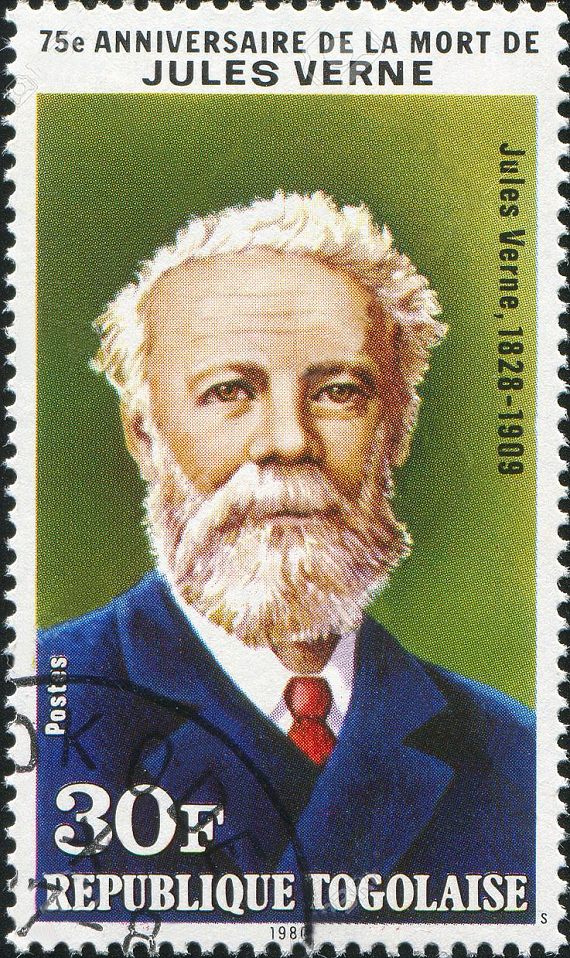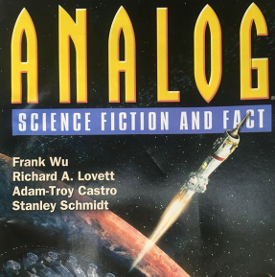
This blog post brought to you by Donald Fish
There’s a “citizens’ board” that helps decide what postage stamps the United States Postal Service (USPS) to issue (let me digress for a moment: remember when it was the United States Post Office [USPO]? Bueller? Anyone? It seems to me that when some company—any company—rebrands itself as a “service,” that actual “service” declines markedly. Just saying. Anyway, back to the column.); and reportedly, they had decided to issue a series of five stamps honouring science fiction writers. Now, the USPS has a long-standing policy of never putting a living person on a stamp, so they decided to use the oldest, biggest names in the “dead person” column. Which caused what some might call a “tempest in a teapot,” and others might call a bit of a shitstorm. (Excuse the bad language; I know Amazing is mostly family-friendly, but sometimes a common phrase isn’t. And “family-friendly” is a moving target anyway, in my opinion.) So after the F&SF review, I think we should talk a bit about this issue. (Pun intended.)

The March/April issue of F&SF has a cover (Figure 2) by Jason Van Hollander for “The Ghost Penny Post,” by Marc Laidlaw, which I guess makes it entirely appropriate for a column which also features postage! The cover is well done in a style which—at least to me—brings echoes to my mind of M.R. James’s fabulous old ghost story, “The Mezzotint.” However, I’m going to review this issue’s stories in order, from fewest words to most words. For no particular reason, and that’s now how they’re presented in the issue, but this has been a particularly odd week and besides, I have a pain in all the diodes down my left side. So there.
The first, or shortest, story of the eleven in this issue is called “Diamond,” by Chris DeVito. It’s a baseball story which, at first glance, could be thought of as an historical alternate-timeline story… or at least that’s what Chris probably wants us to think. It’s one of those stories I like to write as well as read—a near-future short-short with a twist. (I guessed the twist early, but then, I read a lot.) Second story, by N. J. Schrock, called “The Silver Strands of Alpha Crucis-D,” is purely SF. (It’s also her first sale. Congrats to her; a first sale to F&SF is a coup!) The story involves a scientific expedition to a planet where the astronauts find what may be a brand-new form of life. How they discover this, and what they do about it form the basis of the story. Nicely written, in my opinion. Then Paul Di Filippo pops in with a story called “Plumage From Pegasus: the Prince and the Pulpster” which, despite the title, doesn’t really pop with purple prose, thank goodness. However, it is a commentary on the popular view of a writer’s life as seen by the hoi-polloi who wantonly spend their hard-earned shekels on our painfully-produced outpourings. (Goodness, that purple prose, rife with alliteration, is hard to stop once you’ve started, isn’t it?) A very rich man, who has long desired to be a best-selling SF author, finally gets his wish. It ends with an in-joke, which I’m not sure a lot of newer fans will understand. Otherwise, it’s fun. (Oh, and guys? It’s not “Triskets,” it’s “Triscuits.”)
Justin Barbeau chimes in with a short story called “Nanabojou and the Race Question”; one of a series of stories about the trickster Nanabojou. Just about everyone is familiar with The Trickster, who appears in folk tales of many lands; he may appear as Coyote, a spider, a monkey, or whatever, but underneath, he’s The Trickster. Powerful, but not to be trusted, usually.) In this particular case, it comes to Nanabojou that there may be another trickster—or an imitator—working in Virginia; he immediately sets out for Virginia, not having been there for a number of years, to find out about it. He played a trick on the “whiteman” there, a long time ago, and needs to find out what happened with that trick as well as what’s going on now. A nice little commentary couched in a very SF-nal sort of metaphor.
Sheila Finch and Juliette Wade have collaborated on a nice little story involving linguistics, specifically alien linguistics. Ifigenia Chimali, a xenolinguist, has come to the planet Enikiu to help the human ambassador Esteban de las Palmas get a treaty signed with the Oloa. A distant descendent of the Aztecs, Ifigenia has left the Guild headquarters in Geneva to try to facilitate true communication with the Oloa; neither her Guild (the Lingists) nor her grandmother believe she can accomplish anything worthwhile. In fact, her grandmother has accused her of collaborating with invaders, as some Aztecs did with Hernán Cortés. Against this background comes a bigger challenge when Ifigenia’s ship encounters debris, and her ears are damaged; instead of returning to Earth to get them fixed, she must make her “last stand” on Enikiu. What she discovers there will change her life. Good story!
In “Belief,” Nancy Kress challenges belief systems, including religious belief and belief in the scientific method. Andrea is a scientist who works in the Parminter Institute for Biological Studies; her daughter Natalie is a fifteen-year-old who has a need for a connection with something deeper than herself. Natalie wears a locket from her maternal grandmother (Irish). Andrea and her co-workers are seeking something else, but believe the scientific method will provide answers. Both are committed to their own systems, but what happens when systems—and mothers and daughters—collide? Kress doesn’t give you an answer, but she does suggest answers of one sort.
I’m not familiar with James L. Cambias, but I loved his “Golden Gate Blues,” a sort of sf/fantasy/noir piece. Actually laughed out loud when I finished it. Anthony Mace is a sometime P.I. living in the San Francisco Bay area. He’s hired by a Dr. Kraken to find out who killed the Giant Octopus. You know, the one that climbed the Golden Gate Bridge in the movie It Came From Beneath the Sea (clever, wasn’t it, how they blended newsreel footage with stop-motion animation in the movie?). I don’t want to say any more, but fans of genre movies—and noir movies; remember that The Maltese Falcon was also set in San Francisco—will probably like this one too.
The cover story, “The Ghost Penny Post,” by Marc Laidlaw, is an oddity. A combination of Victoriana (set in England, in those days when that Queen in her widow’s weeds ruled much of the “civilized” world) and D&D, it is. Hewell, an inspector for the Royal Mail, meets Deakins, a private detective on the way to Pellapon Hall—residence of the local “squire”—and the village of Binderwood, to try to clear up problems with the mail. One of the problems is that people have taken to this new-fangled method of “letter-writing” with great alacrity; the volume is unbelievable. Whatever happened to civilized converse? Where did the days go when people talked to each other instead of writing letters, each one hastened on its way by a little black rectangle of glued and moistened paper bearing a portrait of Her Majesty? Some people “tsked” to each other, fearing the death of Civilization as We Know It. But underneath all is an older and darker secret, and a different Queen. A fun read, this.
Amazing readers will know Cat Rambo as one of the judges of the first Gernsback Prize short story contest; I first encountered her name in the pages of a newspaper called The Comics Journal, lo these many years ago, which I just found out is still publishing. Her story, “Red in Tooth and Cog,” is a delight. As the so-called Internet of Things becomes more ubiquitous, what happens to discarded small implements with their own AIs? Rambo theorizes that they will attempt to self-repair, living a feral existence in the midst of large cities—perhaps in parks and wildlife areas—and creating a new kind of ecology. Renee, a worker in the city, finds this new ecology and interacts with it to her (and maybe everyone’s) benefit. As I said, delightful. (And a very slight memory surfaces of David R. Bunch’s “Moderans” stories in Amazing’s sister magazine from the ‘70s, Fantastic.)
Sarina Dorie’s “A Mother’s Arms” is told from the point of view of an eight-armed alien on another planet, an “octopillar.” (Kind of a cross between a caterpillar and an octopus.) Although well written—and the alien ecology is very interesting—it has almost the cadence of a children’s book, but don’t let that put you off. Both the story, which is basically an alien “first contact” story, and the writing, make a satisfying combination. And, finally, we come to the longest story in the magazine.
The intro to John P. Murphy’s story, “The Liar,” says “If you’ve ever wondered what the result would be like if Garrison Keillor wrote a Stephen King story, then look no further.” (Keillor, of course, is the host and brains behind NPR’s Prairie Home Companion—I’m just saying this in case you’ve never been lucky enough to encounter him—and King needs no introduction.) Greg Kellog lives in Versailles, New Hampshire (pronounced like the Versailles in Missouri, not the one in France; i.e., “ver-sails”), and he’s a liar. A good one… but the only person or thing he doesn’t lie to is himself. I’ll leave you to discover just what kind of liar Greg is, but he’s not a bad person. Anyway, Greg becomes the new Versailles sexton, and discovers that every year, on November 5, someone—usually a young person—dies in that town. The description given at the start is, in fact, quite apt. Murphy has most of the deftness of both Keillor and King in describing people and places, and the story, not without a scary edge, proceeds to a satisfying conclusion. Overall, a top-notch story, in a top-notch SF/F magazine.

Now, it would be a bit of an exaggeration to say that Millennials don’t know what a postage stamp—or a letter—is; even though the cell phone has, for the most part, replaced not only letter writing (with texting) but also, for many, even talking on the phone. However, for many, letter writing is an antiquated, even quaint idea. Many think that Twitter had the right idea, with messages limited to 127 characters. Odd as it may seem (see Laidlaw’s story), people used to write long—handwritten—missives to each other and mail them; in fact, even in the U.S., daily mail delivery once took place more than once a day! Here in Canada, in fact, Canada Post is attempting to stop home delivery entirely—mail is already only delivered five days a week (and I’ve noticed that mail on Mondays and Fridays is already scarce). But at least the USPS (remember them? See the first paragraph of this column….) still delivers the odd letter, though what is called “junk mail,” usually metered mail (unstamped) forms the bulk of home delivery now, along with packages. But to get to my point—yes, I know, I’m somewhat long-winded—most letters have, in the upper right-hand corner, a postage stamp, that certifies that paid delivery will take place. (Figures 1 and 3).
Stamps for postage (there are other kinds of stamps, such as “Revenue” stamps and “semi-postals, but we’ll skip those for now) generally fall into two categories: the “definitive,” or ordinary postage; and the “commemorative” stamp. Definitives are generally sold in unlimited quantities, but commemoratives are produced in a limited number for a limited time. (There are now also “forever” stamps in both the US and Canada, where the stamp will be usable even if the postal rate rises, but again, these aren’t germane to this discussion.) The USPS has a “Citizens’ Stamp Advisory Committee,” as I said before, that decides what commemorative stamps are approved.
Early in 2013, the USPS declared that they were going to issue a set of five stamps in July 2013, honouring the following SF authors: Isaac Asimov , Ray Bradbury, Philip K. Dick, Robert A. Heinlein and Frank Herbert. Figure 4 shows a proposed Heinlein stamp.

Now, despite the fact that these five are arguably the most famous SF writers in the minds of the general public and that several of them arguably created what we think of as “modern SF,” a general outcry arose among SF fen. (I recently found out—don’t know if it’s true—that “fen” is actually an Esperanto plural for “fan.” As you know, many early fans promoted Esperanto as a solution for world peace. But I digress. As usual.) A petition was started: https://www.change.org/p/the-united-states-postal-service-commemorative-panel-and-the-white-house-honor-60-american-authors-editors-and-artists-of-sf-fantasy-and-horror with the stated reasons being that:
1) The USPS was going to honor just five authors until this past April of 2013, all of them male. This would be a gross misrepresentation of the effect women have had in this field of literature.
2) The general public needs to be made aware of the wide range of people who have affected American AND world culture over the past three generations. Without these creative artists, it’s hard to imagine how anyone could have been influenced to create Star Trek, Star Wars, medical techniques, modern computers and software, communication satellites or the world wide web. (This petition was started by Chris Barkley of “Cincinanti, OH”—I wonder why Chris didn’t know how to spell the name of the city he or she lives in.)
While the petition’s intentions were good and honourable—after all, someone has to speak up for the people society generally ignores, like women and minorities, both visible and invisible, the effect of this outcry was not so good. The series was “indefinitely postponed.” Which is governmentese for “cancelled.”
The list contains writers, artists, filmmakers, male, female, and minorities; a number of whom I would love to have seen on a US stamp—but alas! The likelihood of the USPS issuing a 60-stamp series is and was, vanishingly small. If you follow the link above, you will see that only 213 people signed, and the petition was ultimately cancelled.
Too bad. I’m indebted to Spider Robinson, by the way, for suggesting this as a column subject. And my apologies to Chris DeVito, whose name I misspelled and have now corrected. Sorry, Chris!
I’m looking for comments on this column, good or bad. Sometimes after a couple of weeks without a comment, the silence is deafening, so please let me know what you think of it (the column, the subject, my writing, whatever). You can comment on my Facebook page, or in the several Facebook groups where I publish a link to this column. Your comments are all welcome, and don’t feel you have to agree with me to post one. My opinion is, as always, my own, and doesn’t necessarily reflect the views of Amazing Stories or its owners, editors, publishers or other bloggers. See you next week!











4 Comments